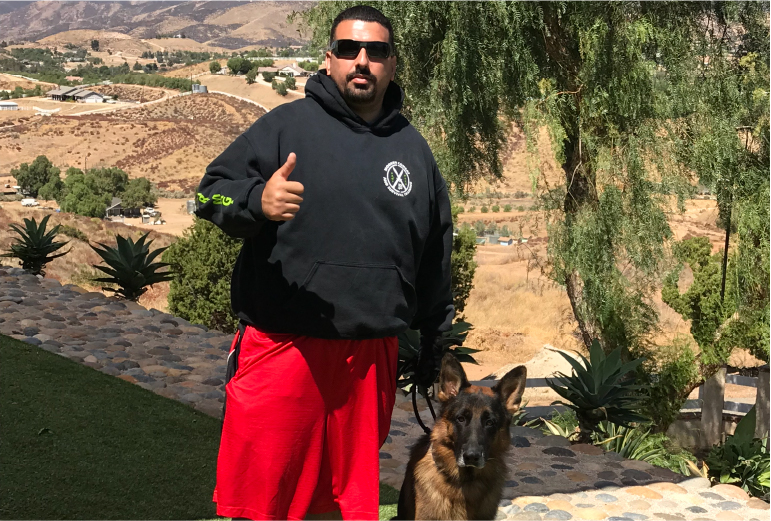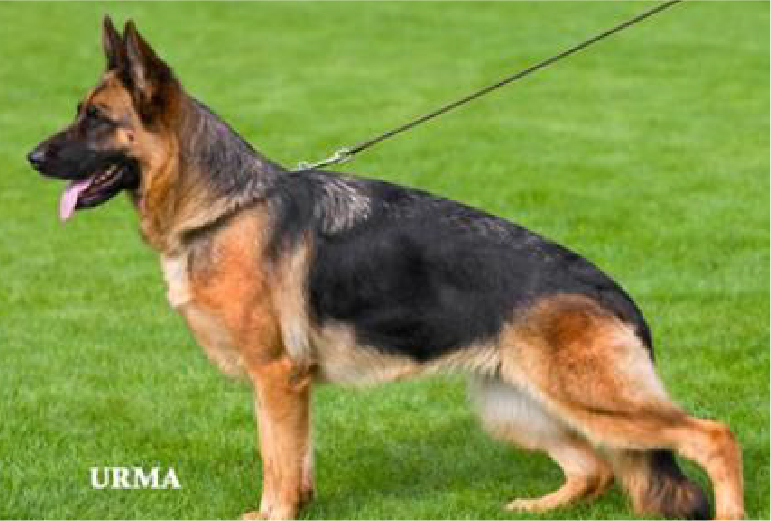
Kempkes Executive K9
One of the main training goals is to control aggression and build up your dog’s protective instincts. A trained dog will know when to stay calm and when to act. This gives you peace of mind, as you can trust your dog to behave properly in different situations.
The controlled aggression assures the security of your family and belongings, managing aggression and encouraging protective behaviors results in a well-rounded dog that can discriminate between actual dangers and everyday circumstances. Your dog becomes an effective protector with the right training orders and techniques. Able to act calmly and obediently in normal situations yet reacting forcefully when necessary.
This post will help you understand how to enhance your German Shepherd’s strong herding instincts, pack mentality, and territorial nature. Have a look!
SUMMARY
- The best age to start your German shepherd’s training should be between 3 and 14 weeks to build confidence and prevent fear-based aggression.
- A better start is from the basic commands like “Heel,” “Watch,” and “Out”, which are necessary for handling a GSD’s behavior.
- A confident German Shepherd is more likely to protect when necessary. Desensitizing them with drills, such as walking on new surfaces or exposing them to various environments, can reduce fear and boost emotional stability.
- Exercise and mental challenges, like scent tracking or problem-solving tasks, are important for fulfilling a GSD’s instincts.
- If your GSD shows signs of aggression or struggles in high-stress situations, working with a professional trainer is recommended.
1. Establish Clear Leadership By Understanding Aggression vs Protection

Kempkes Executive K9
When we talk about German Shepherds, the terms aggressive and protective are often used, but they are two rather different traits. Effective dog training requires you to understand which behavior you’re rewarding and why.
Understanding this difference is crucial for safe and responsible training. Let’s take a closer look at how these behaviors compare:
| Aspect | Aggression | Protection |
|---|---|---|
| Trigger | Fear, anxiety, territorial stress | Real or perceived threat to family/home |
| Reaction Type | Unpredictable, often excessive | Controlled, situational |
| Body Language | Growling, snarling, raised hackles | Focused stance, alert ears, calm posture |
| Motivation | Self-defense, dominance, or insecurity | Loyalty, defense of owner or territory |
| Training Goal | Suppress or redirect aggression | Refine and reinforce controlled responses |
| Risk Level | High (can result in bites or harm) | Lower (dog acts only when necessary) |
| Ideal Response | Train using commands and reinforcement | Train using commands and reinforcement |
In working dog psychology, a nerve-stable German Shepherd will show aggressive signaling (bark, body block, stare) without crossing into conflict behavior (biting without cue). A truly protective dog exhibits drive channeling, redirecting natural prey, defense, or pack drives into trained outcomes like barking on cue, guarding space, or alert posturing.
✅ Training tip: Use canine behavior markers (tail position, body tension, vocal tone) to assess if your dog is defensive-aggressive or confident-protective.
2. Early Socialization for a Confident, Protective Dog
Critical period for socialization: 3 to 14 weeks of age.
German Shepherd puppies need socialization early in life. This time is key in shaping their temperament and protective instincts. During this period, their brains are highly adaptable, a concept known as neural plasticity. It’s the best time to expose them to new experiences. Socialization does more than just provide positive encounters. This builds their confidence and helps them face the world without fear or aggression.
Tactical exposure drills include:
- Introducing uniformed personnel (e.g., mailmen, police officers)
- Exposure to crowds, traffic, and urban noise for desensitization
- Socializing with other dogs and animals to minimize reactivity
To reduce fear-based reactions, use systematic desensitization and counter-conditioning. Teach your puppy to stay calm and focused in the presence of distractions. This helps them develop situational awareness. The goal is to have a protective German Shepherd for your personal protection who can assess threats without acting aggressively. By building these skills early, your puppy will learn to remain alert and controlled in any situation.
✅ Training tip: Start exposing your puppy to real-world scenarios to build a confident, protective mindset.
3. Obedience Training as the Foundation To Control Aggression & Boost Protection
To manage a German Shepherd’s protective behavior, obedience training is crucial. A dog without solid training can have unpredictable, even dangerous responses. It’s important to shape their aggression and make sure they react in safe, controlled ways.
To reinforce the right answers, begin with marker-based training (such as a clicker or vocal cues like “Yes”). Use compulsion-neutral hybrid techniques by combining reward-based methods with controlled leash pressure or e-collar conditioning. This approach enhances reliability, especially in high-stress scenarios where protection might be triggered.
Focus on essential commands that are crucial for protection training:
- “Out” (release command)
- “Watch” (focus and alert posture)
- “Place” (holding ground in a defensive position)
- “Heel” (maintaining control during reactive situations)
✅ Training tip: Start training in low-distraction environments and gradually introduce more stimuli like joggers, loud noises, and other dogs. This prepares your Shepherd for real-world situations, ensuring their protection behavior is both controlled and reliable.
4. Building Confidence Through Training Exercises

Kempkes Executive K9
A confident German Shepherd is more likely to become a protective and aggressive dog when needed. Confidence is built through structured exposure to challenges that promote control over unfamiliar stimuli. This method helps the dog develop emotional stability and strengthens its protective instinct.
i. Begin with environmental desensitization drills
- Walking on unusual surfaces such as metal ramps, grates, or stairs builds the dog’s comfort with varying terrain.
- Confidence tunnels and platform exercises from agility training teach dogs to remain composed and focused in new or uncomfortable environments.
ii. Stress inoculation is another essential part of building confidence
- Gradually increase the stressors your dog faces, like loud sounds, big crowds, or quick movements.
- Every training session should finish with a positive reinforcement cycle. This helps your dog feel a sense of accomplishment..
In addition, implement engagement training tips where the dog must focus on you during stressful situations, such as encounters with strangers or loud noises. This rewires fear-based responses into confident behavior, promoting an assertive protective instinct.
✅ Training tip: Gradually introduce stressors during training. Training your German Shepherd this way helps them manage their aggression; it teaches them to focus on what’s important. Over time, they become a trusted protector, always ready when needed.
5. Teaching Guarding and Protection Commands
A German Shepherd learns protection commands by being trained to react to signals linked with danger. The training shapes how the dog sees a threat and teaches what actions to take. These lessons support the dog’s natural drive to protect people and the spaces they care about.
i. Start with core protection commands
- “Alert” – Instruct the dog to bark when a threat is perceived.
- “Watch him/her” – Direct the dog to maintain a laser-focused stare on the target or intruder.
- “Back” – Command the dog to move backward while maintaining eye contact with the threat.
- “Stand your ground” – Instruct the dog to remain between you and the threat, creating a barrier.
ii. Incorporate operant conditioning into scenario-based drills:
- A stranger approaches: Initially, the dog remains neutral until the “Alert” command is given, prompting a bark.
- A stranger displaying aggression (e.g., fast walking, yelling): The dog steps forward and barks, establishing its defensive position.
✅ Training tip: Use a decoy handler in protective gear to simulate controlled intruder scenarios. Reinforce posture and bark, but do not teach biting unless working under certified protection training.
6. Controlled Exposure to Strangers and Threats
Some dogs don’t know who to protect you from until they’ve seen enough people. That’s why a German Shepherd must meet strangers often, in a controlled setting. The goal is simple: help the dog learn the difference between normal folks and real threats. Only then will it respond with force when it truly matters.
Controlled exposure training involves:
- Using staged actors to simulate both safe and threatening behaviors. Dogs need to stay calm around friendly people or strangers who mean no harm. They shouldn’t react unless someone behaves in a scary way, like yelling, running fast, or charging at them.
- Give rewards only when the dog responds the right way to a real threat. Don’t reward every time. Change the pattern so the dog doesn’t expect it all the time. This helps the good behavior stick. This encourages the dog to remain focused and discerning.
- Body-blocking exercises can help teach the dog to physically position itself between you and a potential threat, increasing its protective behavior.
Additionally, introduce the “threshold cue” method. Teach your dog that only high-stress cues (either from you or the environment) trigger their protective mode, creating a clear response hierarchy. This logic-based approach ensures that the dog’s aggression is controlled and targeted.
✅ Training tip: Gradually increase the intensity of the scenarios, reinforcing your dog’s ability to discriminate threats while maintaining its protective focus.
7. Using Positive Reinforcement for Protective Behavior
Positive reinforcement must be your foundation to make your German Shepherd more aggressive and protective in a controlled and reliable manner. Reward-based systems are scientifically proven to produce more stable, predictable dogs, minimizing the risk of fear-based aggression or misdirected bites toward the handler.
Use functional rewards like:
- Tug toys (which tap into the dog’s prey drive)
- Prey items (bite pillows, flirt poles)
- Verbal praise or high-value treats to shape alert behaviors
Focus rewards on specific protective postures, such as intense eye contact, alert stance, or a single sharp bark—not chaotic reactivity. The goal is to channel aggression into purposeful protection.
- Implement reinforcement shaping through progression:
- Start with clicker-reinforced bark training using the “Speak” command.
- Transition to stimulus-controlled alerting: For example, the doorbell rings → the dog barks once → handler issues “Quiet” → reward follows.
Apply Premack’s Principle to increase motivation: “If you bark once on command, you get to play with your favorite tug toy.” This raises the perceived value of protective behavior and reinforces self-control during activation.
✅ Training tip: Only reward behaviors that reflect focused aggression, not erratic reactions. This builds a balanced, protective mindset in your German Shepherd.
8. Advanced Protection Training (Schutzhund/IPO)
Training your German Shepherd to become more protective and bold can be done in a safe and legal way. A method called Schutzhund, also known today as IPO or IGP, is seen as the best path. This is not just any training; it’s a formal sport that helps working dogs like GSDs grow stronger in their skills. Dogs go through lessons in obedience, tracking, and guard work. This way, they learn to follow commands, stay focused, and protect with control.
Phase Structure
- Obedience Phase: Includes off-leash heelwork, precise sit/down commands under distraction, and rapid recall. These skills create handler control during high-arousal states.
- Tracking Phase: The dog follows a scent trail and identifies and indicates articles. This promotes focus, discipline, and drive control.
- Protection Phase: This phase introduces bark and hold exercises, guarding the handler, escorting the decoy, and performing controlled bites only on command.
Techniques Used
- Drive Channeling: Harnesses the dog’s natural prey and defense drives, converting them into disciplined protective behavior.
- Bark and Hold: The dog delivers an intense bark while maintaining position and awaiting the handler’s release cue—no premature contact.
✅ Training tip: Always pursue Schutzhund/IPO under a certified trainer. It’s the safest and most effective way to build controlled aggression, giving your dog legitimate protection skills while avoiding legal or behavioral liabilities.
Also Read Schutzhund/IPO German Shepherds For Sale
9. Maintaining Physical and Mental Stimulation
To develop a more aggressive and protective German Shepherd, you must continuously fulfill their genetic drives through structured physical and mental engagement. Especially in working-line GSDs, unchanneled energy can quickly turn into misbehavior, anxiety, or misplaced aggression. A high-drive dog needs consistent outlets to maintain balanced, controlled, protective instincts.
Daily Structure
- At least 90 minutes of physical activity: include sprinting, fetch with impulse control, and agility drills to stimulate endurance and coordination.
- 2–3 short problem-solving sessions per day: activities like nosework, food puzzles, or scent tracking exercises encourage mental sharpness.
- Weekly scenario drills: Simulate real-life protection situations such as home-entry alerts or unfamiliar stranger interactions to refine response timing.
Drive Fulfillment Matrix
- Prey Drive: Use tug games, spring poles, and flirt poles to redirect energy toward engagement.
- Defense Drive: Practice guarding postures, controlled barking, and threshold cue training.
- Pack Drive: Bond through structured group walks, controlled off-leash play, and handler-centric routines.
✅ Training tip: Apply rotational engagement—change toys, drills, and locations weekly. This prevents stagnation, builds mental resilience, and keeps your German Shepherd sharp, alert, and ready to protect with purpose.
Mistakes to Avoid When Training Your Dog for Aggression Control
Training a German Shepherd for aggression and protection must be approached with precision. Many well-meaning owners unintentionally create instability or dangerous behavior by making key errors during training. Here are some of the most common (and often overlooked) mistakes that can derail your dog’s development:
1. Reinforcing Unprovoked Aggression
Rewarding barking, growling, or lunging at random people or dogs may seem protective, but it teaches the dog that uncontrolled aggression earns praise. This leads to unpredictable behavior and potential legal issues.
2. Skipping Clear Command Association
Allowing your dog to act without verbal or hand signal cues builds confusion. Protective behavior must always be under clear handler control—random reactions can escalate into dangerous situations.
3. Lack of Deactivation Cues
Many owners focus on “attack” or “alert” cues but fail to teach release commands like “out” or “enough.” A dog that can’t disengage is a liability, not a protector.
4. Inconsistency Between Family Members
A dog gets confused when one person allows guarding while another scolds for the same thing. That confusion can grow and may turn into fear. As a result, the dog might act out with aggression caused by anxiety.
5. Training with Fear or Intimidation
Fear-based training also causes trouble. Shouting, yanking, or using scary tools does more harm than good. German Shepherds are smart; they may stop listening, or worse, they start fearing their owner. That fear turns into aggression or refusal to obey. The bond with the handler suffers, too.
When to Seek Professional Help?
Training at home works well if you’re consistent and stay patient. Still, not every problem can be solved this way; some situations go beyond what you can handle alone. That’s when professional trainers help becomes more than helpful.
Ignoring serious behavior issues can lead to big problems later. Dogs with unchecked aggression might hurt someone, which could bring legal trouble. It could also be unsafe for your family. Recognizing these signs early helps avoid long-term stress and risk.
CALL Michael and Jeannette Today!
Your Calm and Controlled German Shepherd is Just a Call Away – Ready for Your Protection!

You should consult a professional trainer or behaviorist if:
1. Uncontrolled Aggression Emerges Without Cues
Sometimes, your German Shepherd might bark, growl, or jump at people or animals for no reason. These actions may happen when there’s no threat and no command. That means your dog struggles to stay calm and doesn’t know when to react; it shows poor control and confusion in knowing what’s a real danger.
2. Biting Incidents Occur
Any bite, even a warning nip, must be taken seriously. Professional trainers can assess whether it stems from fear, dominance, anxiety, or lack of guidance.
3. You Cannot Recall or Deactivate the Dog
A GSD that ignores commands during high arousal (e.g., “Out,” “Heel,” “Leave it”) may pose a safety risk. Professionals use advanced techniques to regain compliance under stress.
4. Fear-Based or Reactive Behavior Increases
If your dog becomes excessively nervous, jumpy, or aggressive in routine settings (parks, walks, guests entering), a professional can help redirect that energy into constructive behavior.
5. You Want to Begin Formal Protection Training (e.g., Schutzhund/IPO)
Only certified trainers should oversee the bite force or defense aggression training. These disciplines require specialized knowledge to ensure safety, legality, and proper drive development.
FAQs
How old should a GSD be before protection training starts?
Basic training and socialization should begin as early as 8 weeks old. Puppies learn the fastest between 3 to 14 weeks; this is the time to focus on basic obedience. Let them explore, help them feel safe, and start building their confidence early to set the stage. Real protection work comes later, usually around 12 to 18 months.
Are male or female GSDs more protective?
Male and female German Shepherds both protect their families well. But males usually feel a stronger need to guard their space. They might react more quickly and firmly if something seems dangerous. Females are often more handler-focused and cautious, which can translate into thoughtful, strategic protection. The better protector depends on training and individual temperament.
The Bottom Line
The training of German shepherds to control their aggression is not to make them a threat. But it is about building strong confidence, following rules, and learn when and how to act in tough moments.
Training should start when they’re young. Stay steady. Reward good behavior. If it gets hard, a trainer can step in to guide both of you. A protective dog should be steady, alert, and quiet unless there’s real danger. They need to trust you and follow your voice every time.
Fear doesn’t work. Smart steps do. So, build trust, not worry. Keep things clear, not messy. In the end, that’s how your dog learns to keep your family safe.






